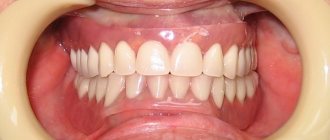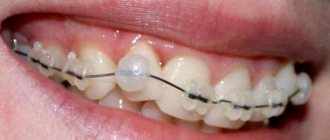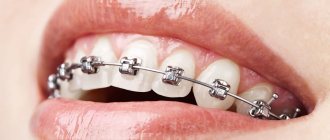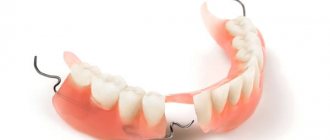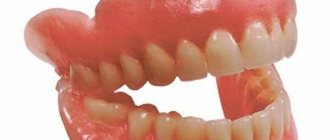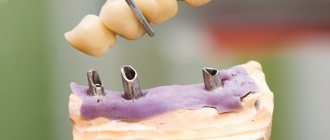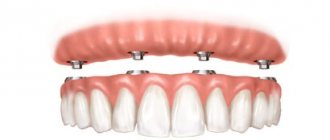20.05.2018
8403
- 1 Reasons for poor fixation
- 2 Consequences of a loose prosthesis
- 3 What to do?
- 4 How to do without dentures?
If the denture is loose on the teeth, this situation is not normal and requires the help of a dentist. Regardless of what type of prosthesis, the structure must hold tightly and not cause discomfort. In rare cases, due to the peculiarities of human anatomy, in the complete absence of teeth, it is difficult to create an ideal fixation structure. In this case, the doctor will advise installing implants as supports to securely attach the prosthesis.
Reasons for poor fixation
Dentures are removable, partially removable and non-removable. Fixed dentures are attached to the teeth themselves with adhesive cement, while other types of dentures are held in the patient’s mouth on the teeth or gums. A person can take off and put on removable dentures himself. And conditionally removable ones can only be done by a specialist in a clinical setting. The problem with instability of prosthesis fastening mainly concerns removable and conditionally removable dentures. The reasons may be as follows:
- Incorrect fit of the prosthesis initially;
- Over time, the size of the gum and jaw have changed;
- Prosthesis care violations.
In rare cases, it happens that even a fixed prosthesis begins to wobble. The reason is that the cement on which the crown was fixed may lose its strength after a few years. In this case, you should immediately contact a specialist who knows how to fix the denture without damaging it. The crown can be carefully removed and reinstalled with new cement. More often, this problem affects those who installed crowns many years ago. Modern cement for fixing the prosthesis is much more durable.
Service life of dentures with hooks
The lifespan of a clasp denture is about five years. Nylon can be used less as it is more flexible and susceptible to deformation. Replacement is required because the fixation strength decreases over time. This occurs due to the gradual resorption of bone tissue and subsequent disruption of the fit of the structure. Due to the fact that clasp dentures correctly distribute the load, the atrophy process is slower. Nylon, due to its softness, allows the process to go faster.
An alternative to clasp fixation is to attach it to locking attachments. Fastening elements are placed on crowns fixed to abutment teeth. Locks allow you to firmly fix the structure.
Author:
Mayorov Andrey Mikhailovich
Specialization:
orthopedic dentistry, dental prosthetics, implant installation
Consequences of a loose prosthesis
Dentures are installed in order to restore the dentition, restore the previous functionality for high-quality chewing of food, and restore the beauty of the smile. The best solution is to install fixed dentures and implants. But sometimes you cannot do without removable, conditionally removable dentures. A well-installed structure is reliable and does not require grinding of adjacent teeth, which is one of the biggest advantages. However, a poorly installed prosthesis leads to many serious problems;
- Constant rubbing of the gums, which can even develop into cancer;
- Distortion of speech and even facial expressions;
- Pieces of food getting under the prosthesis, which leads to inflammatory processes;
- Accidental loss of the prosthesis during a conversation or even during sleep;
- Psychological stress leading to decreased self-esteem and the emergence of self-doubt.
If your denture becomes loose in the first days after installation, you should discuss this with your doctor. Perhaps there are anatomical features that make it difficult for the doctor to achieve ideal fixation of the prosthesis. However, in many cases it is possible to improve fixation through adjustment.
Types of clasps
Depending on the material, clasps for fixing dentures are:
- Metal.
- Plastic or nylon.
- Metal-plastic.
Metal hooks have the lowest aesthetics. They are visible when talking and smiling. Nylon ones are made in the color of the gums, have the required transparency, due to which they are practically invisible to others. Their disadvantage is the incorrect distribution of the load during chewing. The material is soft and cannot provide the required rigidity (unlike less aesthetically pleasing metal).
Depending on the type of fastening, clasps are of dental, gingival and mixed types. According to the manufacturing method - bent, cast and combined.
What to do?
To solve the problem of instability of dentures, advertising suggests using creams such as Corega or Lakalut. The cream fills the entire space between the palate and the structure, ensuring a tight fit. Of course it helps. But it doesn't solve the problem entirely. Because, firstly, when dentures are loose, you will have to use the cream every day, which means additional costs and time. Secondly, not always even a cream can help, which means money wasted. The cream can only be used as a temporary solution. And to solve the issue at its root, you should:
- Contact a specialist for advice and help;
- Adjust the design or order a new one;
- Find another prosthetic option.
In general, each specific case has its own individual solution. For example, if teeth are completely missing, you can use acrylic or nylon dentures. They are perfectly attached due to vacuum, sticking to the gums. A high-quality prosthesis does not require the use of special creams. However, in patients with atrophied bone tissue, when moving the jaw, air can get under the prosthesis, breaking the vacuum. In this case, two implants are placed, and the structure is held securely.
If not all teeth in the mouth are lost, but the upper denture, which is conditionally removable, does not hold, there is a solution for this too. Such designs can be plate, nylon, or clasp. They are fixed with clasps, hooks, and gingival processes. If the structure is unstable, you just need to tighten the fastening. But you can’t do it yourself, you might accidentally break it. You can only trust the work to a doctor.
When is the use of additional funds justified?
People who wear pullers do not always have confidence that the devices are well fixed and will not fail at the most inopportune moment. Therefore, additional means of fixation are used quite widely. They also have a number of functions:
- at the beginning of wearing they help to adapt to artificial structures in the oral cavity, accelerating addiction,
- prevent particles of food, liquids and air from getting under the prosthesis, ensuring tightness,
- protect the mucous membrane from mechanical irritation, rubbing and subsequent inflammation due to the content of anti-inflammatory components,
- when using products with refreshing ingredients (not all have them), they give freshness to your breath,
- prevent the structures from moving and falling out during long-term use if the position of the gums changes.
However, it is important to remember that additional means of fixation in case of long-term use of the structure do not replace a trip to an orthopedist for its relocation, repair or replacement with a new one. Their use is justified with high-quality structures for additional stability in the oral cavity.
1Samusenkov V.O. [and others] Rational approaches to prosthetic treatment of patients with diseases of the oral mucosa / Dentistry for everyone. – 2014. 2Zholudev S.E. Features of prosthetics with complete removable dentures and adaptation to them in elderly and senile people / Ural Medical Journal. – 2012.
Author: Dulgarov Zh. G. (Thank you for your help in writing the article and the information provided)
How to manage without dentures?
Alas, you cannot do without prosthetics. The loss of even one tooth disrupts the harmony in the oral cavity. In place of a lost tooth, the skin becomes less elastic, the correct oval of the face is lost over time, and signs of aging appear. The load on the remaining teeth increases. The jaw bone becomes thinner and the gum structure changes.
After tooth extraction, less blood flows into this area of tissue, and the number of blood vessels in the area where the tooth is missing decreases. As a result, the structure of the jaw bone is disrupted. All these processes then lead to displacement of the dentition, to an incorrect bite. And this, in turn, affects the quality of chewing food and disrupts the digestion process.
Even a person’s speech is impaired. Due to the absence of individual teeth, it is impossible to pronounce some sounds correctly. Especially if the problem affects the front teeth. Moreover, the absence of the front row of teeth leads to changes in the nasolabial fold. It lengthens, the corners of the mouth droop, and the person begins to look older than his age.
The dentition needs to be restored using dentures. Modern types of prosthetics allow you to make the most ideal choice in each specific case. Problems with wobbly structures can be eliminated. And the problems that arise due to damaged dentition are irreversible.
Additional means of fixing dentures
Additional means include special compounds that help to hold removable structures due to their properties - viscosity and adhesiveness. You can buy them at any pharmacy. They are indispensable when devices are at the very beginning of use and can cause some discomfort, as well as over time, after several years of active use, when the fastening system gradually weakens. How can you additionally secure a denture:
Fixing adhesives, creams and gels
They are presented in a wide range on the market. Their composition is approximately the same, the adhesion of the surfaces occurs due to the action of polymers that glue them together. There are well-known products to choose from: Corega, Rox, Fittident, Protefix and others. They can be used to fix a complete removable denture, both lower and upper, as well as partial, on the gums. If the device falls out of your mouth, glue or cream will help to quickly secure it.
Which of these is better for fixing dentures depends on the doctor’s recommendations in a particular case, the presence or absence of allergies, the condition of the oral cavity, and personal preferences.
Which cream is best suited for each specific situation, read the article on the website “Review of the best creams for fixing dentures: features of composition and application.”
Special prosthetic pads
They are available for lower and upper removable devices. Made of special fiber in the shape of an arc on the gums or plates on the palate. They serve as a layer between the structure and the gum, providing stability. Their function is to protect the mucous membrane from chafing when getting used to the devices, and to securely hold it.
Read more about this product in the material “Why do you need spacers for dentures: application features and a review of popular brands.”
Special stripes
They are similar to gaskets, but are used if there are bite pathologies. They are coated with an adhesive composition, which must be heated in warm water before use. The warm strip is glued to the denture and inserted into the mouth along with it. This remedy protects the mucous membrane from displacement of the apparatus and the occurrence of inflammation, and if it occurs, it reduces pain and promotes tissue healing.
Powder products
Also an adhesive composition, but in powder form. It is necessary for those patients who have insufficient salivation. The powder “seizes” in the mouth and holds the structure well. True, it is more difficult to distribute evenly than paste-like products.
Which of these fixes dentures better depends on the patient’s situation, at what period of wearing he turned to the help of these products, as well as what is the situation in the oral cavity, whether there are inflammations, wounds, etc.
Do I need to take breaks and remove the prosthesis at night?
Many patients do not wear dentures all the time, and they especially often take them out at night. There is no such need. There is no need to remove the denture from your mouth at night. The prosthesis cannot be swallowed and cannot be used during sleep. You shouldn't take breaks during the day either. Even if your jaw is tired, your gums are tired, you want to rest - you have to endure it. It is important to understand that if you remove the denture, the jaw and mucous membranes become unaccustomed to it. And when you put on the prosthesis again after a while, the addiction will begin again. The mucous membrane begins to hurt more, the jaw gets more tired. Practice shows that very often people who take breaks after a few days simply stop wearing a removable denture.
Wearing a new removable denture all the time can be difficult, but it allows you to get used to the denture in just 2, maximum 3 weeks.
Sections / Dental prosthetics
